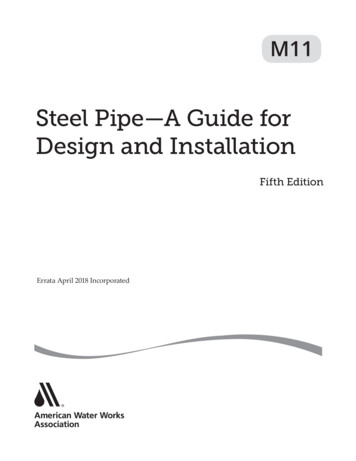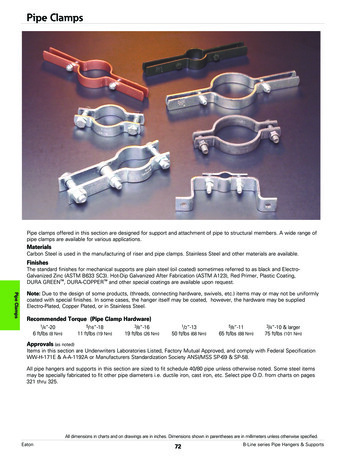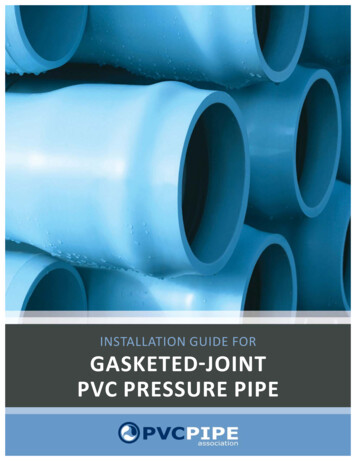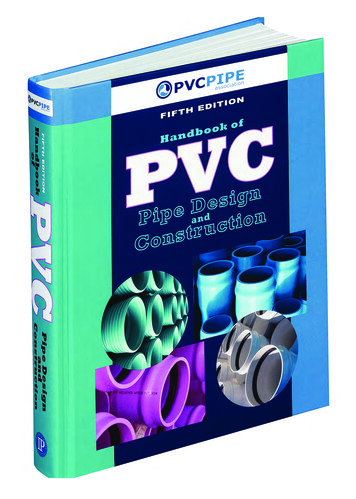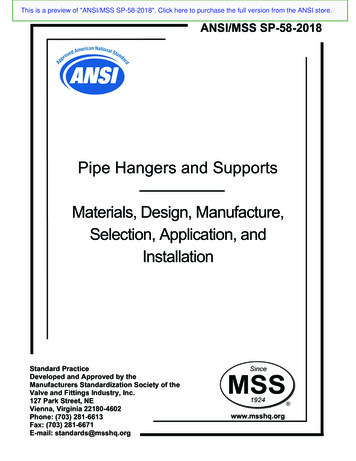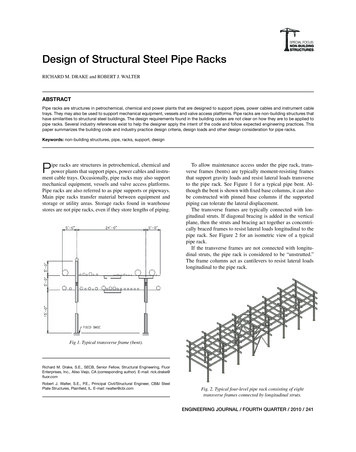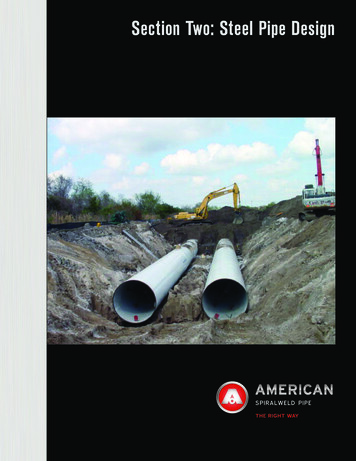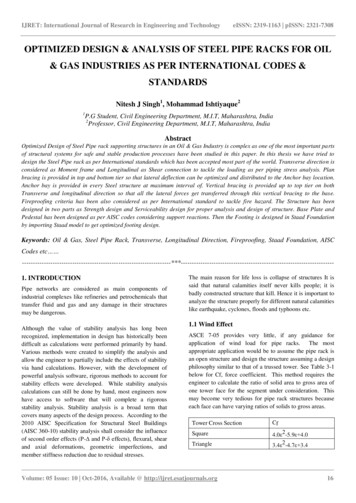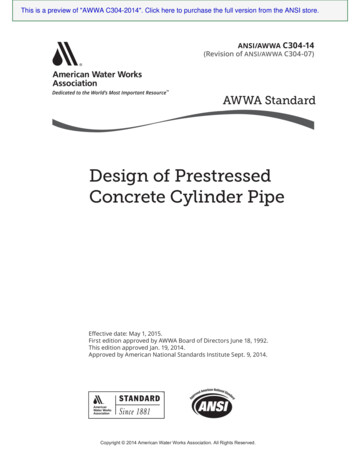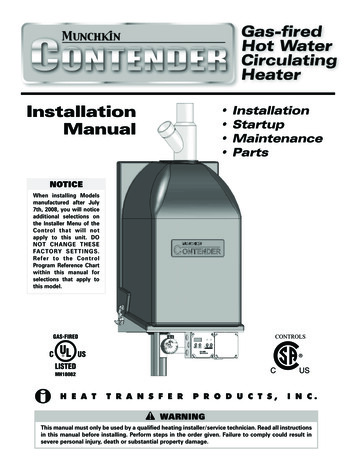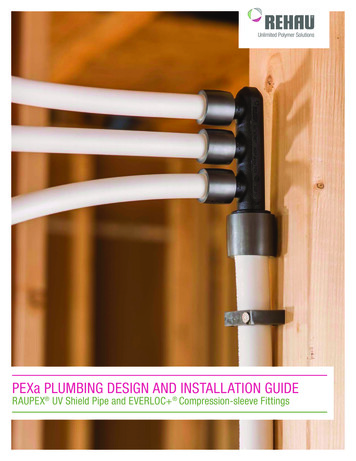
Transcription
PE Pipe—Designand InstallationAWWA MANUAL M55First EditionScience and TechnologyAWWA unites the drinking water community by developing and distributing authoritative scientific and technologicalknowledge. Through its members, AWWA develops industry standards for products and processes that advance publichealth and safety. AWWA also provides quality improvement programs for water and wastewater utilities.Copyright 2006 American Water Works Association. All Rights Reserved.
ContentsList of Figures, viiList of Tables, xiList of Terms and Equation Symbols, xiiiList of Conversions, xviiMetric Conversions, xviiCelsius/Fahrenheit Comparison Graph, xxiDecimal Equivalents of Fractions, xxiiPreface, xxiiiAcknowledgments, xxvChapter 1Engineering Properties of Polyethylene.1. 21Introduction, 1Polymer Characteristics, 1Mechanical Properties, 3Other Physical Properties, 7Chemical Properties, 9Environmental Considerations, 12Long-Term Properties, 13Industry Standards, 15Conclusion, 18References, 18Chapter 2Manufacturing, Testing, and InspectionIntroduction, 21Pipe Manufacture, 22Fittings Manufacture, 23Testing and Inspection, 25Conclusion, 27References, 27Chapter 3Hydraulics of PE Pipe. 29. 39Introduction, 29Determining the Flow Diameter of a PE Pipe, 29Friction Head Loss, 30Darcy-Weisbach Friction Factor, 30Hazen-Williams Formula, 36Fittings, 37Air Binding, 38Chapter 4Working Pressure Rating.Introduction, 39Pressure Class, 40Surge Considerations, 41Working Pressure Rating, 44iiiCopyright 2006 American Water Works Association. All Rights Reserved.
Molded and Fabricated Fittings, 47References, 48Chapter 5External Load Design. 49. 73Chapter 7 Transportation, Handling, and Storage of Pipeand Fittings . . . . . . . . . . . . . . . . . . 91. 99Introduction, 49Dead Loads, 50Live Loads, 51Surcharge Loads, 54Ring Deflection, 57Wall Buckling, 61Wall Compressive Stress, 63Design Window, 64Example No. 1, 65Example No. 2, 67Example No. 3, 68Example No. 4, 69Example No. 5, 70References, 70Chapter 6Joining and Fittings.Heat Fusion Joining, 73Mechanical Joining, 80Mainline Fittings, 84Branching and Tapping, 86Service Connections, 87References, 88Receiving Inspection, 91Product Packaging, 91Checking the Order, 92Load Inspection, 92Receiving Report and Reporting Damage, 94Unloading Instructions, 94Unloading Site Requirements, 94Handling Equipment, 94Unloading Large Fabrications, 95Preinstallation Storage, 95Pipe Stacking Heights, 95Exposure to Ultraviolet Light and Weather, 96Cold Weather Handling, 96Field Handling, 96Chapter 8Installation.General Considerations, 99Underground Installations, 99Special Installation Techniques, 113Marine Installations, 116References, 126ivCopyright 2006 American Water Works Association. All Rights Reserved.
Chapter 9Hydrotesting and Commissioning.127.133Flushing, 127Filling, 127Leak Testing, 127Records, 130Disinfection, 130Commissioning, 131References, 131Chapter 10 Maintenance and Repairs.Disinfecting Water Mains, 133Cleaning, 133Maintenance, 133Repairs, 134New Service Connections, 136New Connections to Mains, 140References, 141Index, 143AWWA Manuals, 151vCopyright 2006 American Water Works Association. All Rights Reserved.
AWWA MANUALChapterM551Engineering Propertiesof PolyethyleneINTRODUCTIONA fundamental understanding of material characteristics is an inherent part of thedesign process for any piping system. With such an understanding, the pipingdesigner can use the properties of the material to design for optimum performance.This chapter provides basic information that should assist the reader in understandinghow polyethylene’s (PE’s) material characteristics influence its engineering behavior.PE is a thermoplastic, which means that it is a polymeric material that can be softened and formed into useful shapes by the application of heat and pressure and whichhardens when cooled. PE is a member of the polyolefins family, which also includespolypropylene. As a group of materials, the polyolefins generally possess low waterabsorption, moderate to low gas permeability, good toughness and flexibility at lowtemperatures, and a relatively low heat resistance. PE plastics form flexible but toughproducts and possess excellent resistance to many chemicals.POLYMER CHARACTERISTICSIn general terms, the performance capability of PE in piping applications is determined by three main parameters: density, molecular weight, and molecular weightdistribution. Each of these polymer properties has an effect on the physical performance associated with a specific PE resin. The general effect of variation in thesethree physical properties as related to polymer performance is shown in Table 1-1.DensityPE is a semicrystalline polymer composed of long, chain-like molecules of varyinglengths and numbers of side branches. As the number of side branches increases, polymer crystallinity and hence, density decreases because the molecules cannot pack as1Copyright 2006 American Water Works Association. All Rights Reserved.
2PE PIPE—DESIGN AND INSTALLATIONTable 1-1Effects of density, molecular weight, and molecular weight distributionAs Density IncreasesAs Molecular WeightIncreasesAs Molecular WeightDistribution reases slightlyDecreasesImpact strengthDecreasesIncreasesDecreasesLow temperature brittlenessIncreasesDecreasesDecreasesAbrasion creases slightly—Softening pointIncreases—IncreasesPropertyTensileStress crack ecreasesIncreases slightly—Chemical esMelt strengthclosely together. Density affects many of the physical properties associated with theperformance of the finished pipe. Properties such as stress crack resistance, tensilestrength, and stiffness are all affected by the base resin density of the polymer asshown in Table 1-1.Base resin density refers to the density of the natural PE that has not been compounded with additives and/or colorants. Within this range, the materials are generically referred to as either medium or high density in nature. PE pipe resins with abase resin density in the range of 0.935 to 0.941 grams per cubic centimeter (g/cc) arereferred to as medium density PE. PE pipe base resins in the range of 0.941 to 0.945 g/ccare commonly referred to as high-density polyethylenes (HDPEs). Industry practicehas shown that base resin (unpigmented) densities in the range of 0.936 to 0.945 g/ccoffer a highly beneficial combination of performance properties for the majority of piping applications.The addition of carbon black to the base PE resin does have an impact on the compounded density of the material. The addition of 2 to 2.5 percent carbon black raisesthe compounded material density on the order of 0.009–0.011 g/cc. The variability inthe actual percentage of carbon black incorporated can have a moderate affect on comparative density values. As a result, industry practice as established by ASTM standard is to provide comparative values on the base resin density as this is a betterindicator of the polymer crystallinity.Molecular WeightPE resins are composed of a number of molecular chains of varying lengths. As aresult, the molecular weight of the resin is the average of the weight of each of thesechains. The average weight may be determined using sophisticated scientific techniques, such as gel permeation chromatography or size-exclusion chromatography. ForPE of a given density, the effect of increasing molecular weight on physical propertiesis shown in Table 1-1.A very rough indicator of the molecular weight of a polymer may be obtained usingthe melt index technique of analysis as described in ASTM D12381. The melt index technique is an inexpensive means of comparing, in a relative manner, the molecular weightof PEs having similar structure. Resins with a relatively low average molecularCopyright 2006 American Water Works Association. All Rights Reserved.
ENGINEERING PROPERTIES OF POLYETHYLENE3weight will have a comparatively high melt index. Conversely, resins with a relativelyhigh molecular weight will yield a lower melt index. From this relationship, we canassociate changes in physical properties (as shown in Table 1-1) with changes in meltindex of the material. It is important not to use melt index alone as a definitive indicatorof molecular weight because variations in polymer structure can affect both molecularweight and melt index.Molecular Weight DistributionMolecular weight distribution (MWD) refers to the statistical grouping of the individual molecular chains within a PE resin. Resins made up of molecules that vary considerably in molecular weight are considered to have a broad MWD. When most of themolecules are nearly the same length, the MWD is considered narrow. The effect ofbroadening the MWD of a PE resin having a given density and molecular weight isshown in Table 1-1.Recent AdvancesIt should be noted that recent advances in polymer technology have led to the development and introduction of even higher density resins for use in piping applications.These new materials that have base resin densities as high as 0.952 g/cc in combination with higher molecular weight and bimodal molecular weight distribution are generally recognized as offering higher levels of technical performance under ISOstandards for PE piping that are common outside of North America. These higher levels of technical performance are not yet recognized within the North American standards system.MECHANICAL PROPERTIESViscoelasticityPE is characterized as a viscoelastic construction material. Because of its molecularnature, PE is a complex combination of elastic-like and fluid-like elements. As aresult, this material displays properties that are intermediate to crystalline metalsand very high viscosity fluids. Figure 1-1 is the traditional diagrammatic representation of PE in which the springs represent those components of the PE matrix thatrespond to loading in a traditional elastic manner in accordance with Hooke’s law. Thedashpots represent fluid elements of the polymer that respond to load much as a Newtonian fluid.As a result of the viscoelastic character of the polymer, the tensile stress–straincurve for PE is divided into three distinct regions. The first of these is an initial lineardeformation in response to the load imposed that is generally recoverable when theload is removed. In the second stage of loading, deformation continues but at an everdecreasing rate. Thus, the slope of the stress–strain curve is constantly changing,attesting to its curvilinear nature. Deformation in the second stage may not be fullyrecoverable. The final stage of the stress–strain curve for PE is characterized by necking down followed by distinct elongation or extension ultimately ending in ductile rupture of the material.The viscoelastic nature of PE provides for two unique engineering characteristicsthat are employed in the design of HDPE water piping systems. These are creep andstress relaxation.Copyright 2006 American Water Works Association. All Rights Reserved.
4PE PIPE—DESIGN AND INSTALLATIONε1ε2ε3δ0Figure 1-1Strain ε1 ε2 ε3Traditional model of HDPECreep is not an engineering concern as it relates to PE piping materials. Creeprefers to the response of PE, over time, to a constant static load. When HDPE is subjected to a constant static load, it deforms immediately to a strain predicted by thestress–strain modulus determined from the tensile stress–strain curve. The materialcontinues to deform indefinitely at an ever decreasing rate. If the load is high enough,the material may yield or rupture. This time-dependent viscous flow component ofdeformation is called creep. This asserts that the long-term properties of PE are notadequately predicted by the results of short-term testing, such as tensile strength. Assuch, PE piping materials are designed in accordance with longer-term tests such ashydrostatic testing and testing for resistance to slow crack growth, which when usedin accordance with industry recommended practice, the resultant deformation causedby sustained loading, or creep, is not sufficiently large to be an engineering concern.Stress relaxation is another unique property arising from the viscoelastic nature ofPE. When subjected to a constant strain (deformation of a specific degree) that ismaintained over time, the load or stress generated by the deformation slowlydecreases over time. This is of considerable importance to the design of PE pipingsystems.Because of its viscoelastic nature, the response of PE piping systems to loading istime-dependent. The effective modulus of elasticity is significantly reduced by theduration of the loading because of the creep and stress relaxation characteristics ofPE. An instantaneous modulus for sudden events such as water hammer can be ashigh as 150,000 psi at 73 F (23 C). For slightly longer duration, but short-term eventssuch as soil settlement and live loadings, the effective modulus for PE is roughly110,000 to 120,000 psi at 73 F (23 C), and as a long-term property, the effective longterm modulus calculates to be approximately 20,000 to 38,000 psi. This modulusbecomes the criteria for the long-term design life of PE piping systems.This same time-dependent response to loading is also what gives PE its uniqueresiliency and resistance to sudden, comparatively short-term loading phenomena.Copyright 2006 American Water Works Association. All Rights Reserved.
ENGINEERING PROPERTIES OF POLYETHYLENE5Such is the case with PE’s resistance to water hammer, which will be discussed inmore detail in subsequent sections.PE is a thermoplastic and, as such, its properties are temperature dependent aswell as dependent on the duration of loading. Therefore, the absolute value of
AWWA unites the drinking water community by developing and distributing authoritative scientific and technological knowledge. Through its members, AWWA develops industry standards for products and processes that advance public health and safety. AWWA also provides quality improvement programs for water and wastewater utilities. PE Pipe—Design and Installation AWWA MANUAL M55 First Edition .File Size: 491KBPage Count: 23
